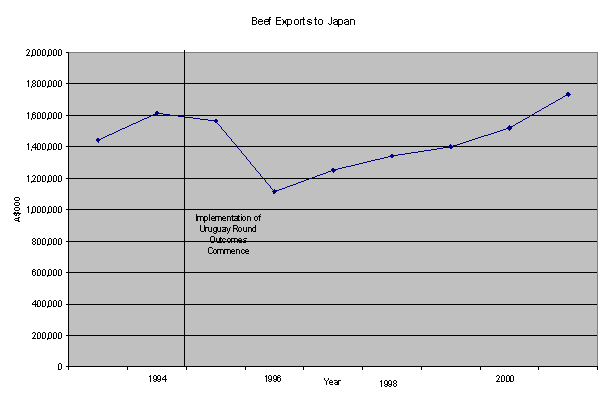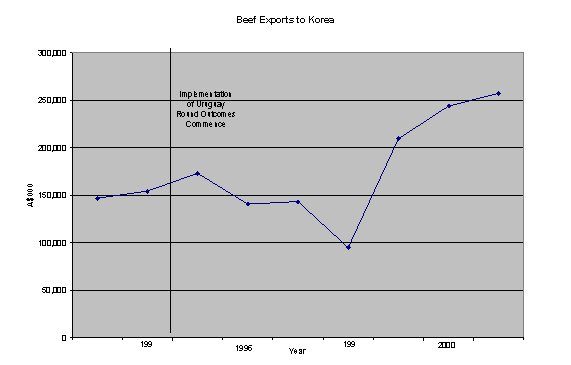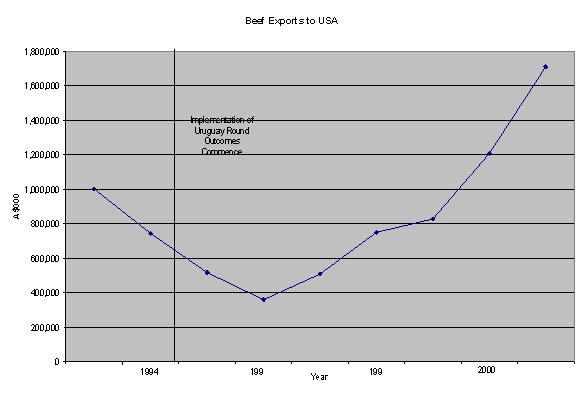| Connections |
| Home |
| Index
of Papers |
| Guidelines |
|
Connections - Farm, Food and Resource Issues |
NEGOTIATING WINS FOR AUSTRALIA IN AGRICULTUREAllan McKinnon, Special Negotiator for Agriculture, Department of Foreign Affairs and Trade In November 2001 Ministers from 144 members of the World Trade Organisation (WTO) meeting in Doha, Qatar agreed to launch a new round of broad-based trade negotiations. This was a welcome outcome for Australia – not only because the launch of a new round of trade negotiations was our highest trade policy priority, but also because the Ministerial Declaration launching the Round addressed all of Australia’s key concerns. For Australia this successful outcome involved extensive technical work and dialogue and negotiations - at home with domestic stakeholders, and abroad working alongside the WTO-member partners with whom Australia shares common interests of strengthening to the greatest extent possible the rules of international trade. One of the most important outcomes for Australia in the Doha Ministerial Declaration was the inclusion of ambitious language which opens the way for comprehensive negotiations further to reform global agricultural trade. The mandate agreed in Doha provides for “substantial improvements in market access; reductions of, with a view to phasing out, all forms of export subsidies; and substantial reductions in trade-distorting domestic support.”[1] Australia’s negotiating objectives are for agriculture to be fully integrated into the WTO rules; for agricultural tariffs to be brought down to the level of those in other goods; to eliminate the billions of dollars spent every year on export subsidies; and substantially reduce the billions spent every week on distorting domestic support. We are under no illusions about the enormity of this task. Seven years after the end of the Uruguay Round, world markets for agricultural products are still characterised by huge subsidies and high levels of protection. In 2000, the OECD reported that its members provided US$ 327 billion in subsidies to agriculture – compared with US$ 43 billion in developed country aid to developing countries.[2] These are depressing statistics for an efficient agricultural producer like Australia, and also for the developing countries making up the bulk of the Cairns Group, which rely heavily on their agricultural sectors for growth and development. Confronting this bleak picture, it is sometimes easy to overlook the importance for Australia (and the Cairns Group) of achieving agreement in the WTO seven years ago to a legally binding instrument dealing with trade in agricultural commodities. But now, as we embark on another round of multilateral negotiations, it is important to remind ourselves of the fundamental importance and relevance of the Agreement on Agriculture. Firstly, long experience has shown that the problems of agricultural support and protection cannot be addressed effectively by trade liberalising methods such as bilateral Free Trade Agreements. This is partly because of the political dynamic but partly also because it is not possible to address subsidies which have a global impact in the context of a purely bilateral FTA. It is through continuing to negotiate at the multilateral level that we and coalition partners in the Cairns Group maximise our push for reductions in trade distorting measures that will translate into meaningful gains in global agricultural trade. Secondly, inclusion of the Agreement on Agriculture into the body of GATT law means members have recourse to WTO dispute settlement mechanisms to resolve agricultural trade disputes. The dispute settlement system, “a central element in providing security and predictability to the multilateral trading system”[3], provides for a system of both compulsory and binding jurisdiction, with remedies for the enforcement of rulings. To date Australia has successfully prosecuted four WTO complaints, all of which have resulted in improved market access for agricultural commodities. These include:
Thirdly, the Agreement on Agriculture has conferred some real benefits on Australian agricultural exporters – market access improvements for Australian agricultural products being the primary and most visible of these. This not only includes outcomes negotiated during the Uruguay Round itself, but also outcomes achieved when countries acceding to the WTO have to agree to a package of market opening measures and changes in their domestic regulations as part of that accession process. In the latter regard China’s recent entry into the WTO and attendant reforms undertaken by China in its agriculture sector will provide new opportunities for Australian exporters to secure a much larger share of an expanding commodities market including in barley, cotton, sugar, wheat and canola. Market access winsImprovements in access to export markets are rarely defined by a single event or outcome. In the seven years since Uruguay Round Agreements entered into force, Australian successes in developing or forging new markets for agricultural exports have been influenced by a range of factors - economic crisis in East Asia, devaluation of the Australian dollar, strengthening/weakening of commodity prices in response to supply/demand factors, the global slowdown post September 11, outbreaks of disease and climatic events. However, important in underpinning improvements in market developments for a number of Australian exports have been the range of market access agreements and support reduction commitments arrived at during Uruguay Round negotiations. For instance the Uruguay Round access into Japan for certain cheeses has underpinned a strong export performance by the Australian dairy industry, with cheese exports to Japan increasing from A$150 million in 1994 to A$340 million in 2000. Globally, Australian exports of dairy products have doubled, from A$1.3 billion in 1994 to $ 2.6 billion in 2000.[4] Prior to the Uruguay Round many Asian rice markets were closed or highly restricted to Australian exports of rice. During the Round, Australia negotiated market openings in a number of Asian countries. As a result, available markets increased in value from less than US$250 million in 1990 to more than US$2.5 billion in 1999.[5] Australia’s higher-priced, higher-quality rice has made real inroads in the Japanese markets. Australia has just won its first tender for rice to Korea. Beef exports markets into Japan, US and Korea have also benefited considerably as a result of Uruguay Round outcomes. The remainder of this paper is devoted to a brief case study of beef exports into these three markets. Australian beef exportsIn its submission to a House of Representatives Standing Committee inquiry into the benefits to rural Australia of international agricultural trade reform, Australian meat and livestock industries estimated that liberalisation of beef markets in 2001 in Japan, Korea, the European Union, United States and Canada will provide gains up to A$4.93 billion over the period up to 2011[6]. Modelling for the same submission has indicated that the opening of the Japanese and Korean markets in particular in 1990-1997 have increased the gross value of Australian production by around 10 per cent – with prices rising 3 per cent on average and export sales increasing by 7 per cent.[7] JapanLiberalisation of Japan’s beef market began in 1989 with the removal of quantitative restrictions, replaced with tariffs which are declining over time. In the Uruguay Round, Japan committed itself to further reductions in tariffs from 50% in 1993 to 38.5% by the end of the implementation period in 2000 with a safeguard clause which permitted the Japanese government to raise the tariff to 50% for a limited period if imports exceeded a critical level.[8] The safeguard has been triggered on several occasions. Graph 1
Source: ABS statistics Liberalisation and associated reductions in prices for Japanese consumers have led to significant increases in imports over the first half of the 1990s (reflected in graph 1) ABARE analysis suggests that this growth may have been greater had the entire price reduction been passed on to consumers. Relative lack of competition in the Japanese retail market has been cited as the reason that this did not occur.[9] The mid-1990s shows a steep dip in exports – a function of decreased demand with the onset of the East Asia crisis. From 1997 onwards a period of relative static demand - but starting from a higher base than in the pre-liberalisation period - has reflected flat incomes and health and safety concerns about imported beef. KoreaAustralian beef markets into the Republic of Korea have doubled in value since the conclusion of the Uruguay Agreement on Agriculture was finalised. Korean commitments during the Uruguay Round included a quota increase from 123,000 tonnes to 225,000 tonnes over the five year implementation period with complete quota elimination by 2001, when the market moved to a tariff-only basis. Associated with this was a tariff quota reduction from 43.6% in 1995 to 40% in 2004. Removal of restrictions on imported beef is estimated to increase Australian beef sales to Korea from 70,000 tonnes to 90,000 tonnes by 2002, a gain of approximately A$200 million per year. Graph 2 tells the story of Australian beef exports to Korea with a steep dip in growth over the period of the East Asian crisis with Korea unable to meet its minimum import requirements in 1998[10]. Recovery of the Korean economy on the back of strong commodity prices and a depreciating Australian dollar has prompted an increase in demand for beef. The successful challenge in the WTO by Australia and the US against discriminatory measures imposed by Korea for imported beef, ranging from the imposition of discriminatory border measures through the entire distribution chain to retail butcher shops is expected further to bolster strong demand. Graph 2
Source:
ABS statistics United StatesUS commitments on beef during the Uruguay Round included replacement of the Meat Import Law with tariff-only protection and increased access through tariff quotas. This led to an immediate increase of 17% in access in 1995 compared with the level in 1994 and a global quota of 656,621 tonnes of which Australia had a 57.6% market share[11]. The out-of-quota tariff rate decreased minimally – from 31.1% to 26.4% from 1995-2000. Graph 3 reflects the value of beef exports to the US market. During 1999, 34 per cent of Australia’s beef exports were to the United States. Graph 3
Source: ABS statistics More difficult to measure in terms of market access implications, but no less significant for beef outcomes was US agreement during the Uruguay Round to reduce the volume of beef eligible for export subsidies from 22,265 tonnes in a 1986-1990 base year to 17, 589 tonnes by 2000. Similarly the European Union reduced by 26% its subsidised beef exports. We consider this to be a major factor accounting for the increase in exports of chilled and frozen beef to Russia, from 4522 tonnes in 1996-97 to 29,402 tonnes in 1997-98. Reductions in EU export subsidies also led to Australia being more competitive in markets such as Bulgaria, Croatia, Hungary and South Africa.[12] ConclusionSuccess in moving forward Doha agriculture negotiations requires sustained enthusiasm and commitment. This must be underscored with a clear sense of the importance and relevance of the Agreement on Agriculture, and an understanding of the scope for potential real benefits to Australia’s agriculture sector. ReferencesABARE
(2001) Agricultural Trade Policies in Japan: The
Need for Reform, “Benefits to
the meat and livestock industry from agricultural trade reform”, Australian
meat and livestock industries’ submission to the House of Representative
Standing Committee inquiry into the benefits to rural Australia of
international agricultural trade reform (1997) DFAT (1994) Uruguay Round Outcomes: Agriculture DFAT
(1999) Trade Outcomes and Objectives Statement, DFAT (2000) Composition of Trade Australia East Asia Analytical Unit (DFAT) (1999) Korea Rebuilds: From Crisis to Opportunity, OECD
(2000) Agricultural Policies in OECD Countries: Monitoring and Evaluation,
[1] Doha Ministerial Declaration, WTO Secretariat WT/MIN(01)/DEC/W/1 [2]
Agricultural Policies in OECD
Countries: Monitoring and Evaluation, OECD (2000), p26. [3] Article 3.2 of the Understanding on Rules and Procedures Governing the Settlement of Disputes. [4] Composition of Trade Australia, 2000, DFAT, p213. [5] Uruguay Round Outcomes: Agriculture, DFAT (1994) pp26-30; DFAT STARS database. 6.
“Benefits to the meat and livestock industry from agricultural trade
reform”, Australian meat and livestock industries’ submission to the
House of Representative Standing Committee inquiry into the benefits to
rural Australia of international agricultural trade reform (1997), p9. [7]
ibid. p4. [8] op cit, DFAT (1994), p21. [9]
Agricultural Trade Policies in Japan: The Need for Reform, ABARE(2001),
p49. [10]
Korea Rebuilds: From Crisis to Opportunity, East Asia Analytical Unit (DFAT),
(1999), p129. [11]
op cit. DFAT (1994), p18. [12]
Trade Outcomes and Objectives
Statement, DFAT (1999), p225.
|


